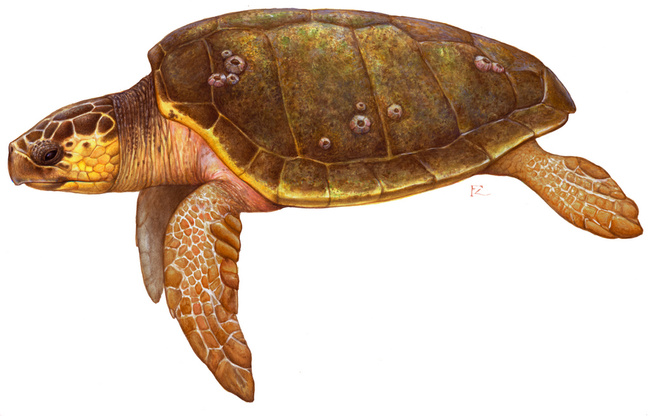Loggerhead Sea Turtle
Loggerhead Sea Turtle (Caretta caretta) Spanish Name: Caguama

More about Loggerhead Sea Turtle
Habitat
This sea turtle is often spotted swimming in coral reefs and shipwrecks.
Range
The loggerhead is found among tropical and subtropical regions in the Pacific, Atlantic, and Indian oceans.
Physical Description
This is the largest sea turtle in the world with a hard shell. As big as it is today, in the past it reached gigantic sizes (see below). The loggerhead's immensity is surpassed only by the soft-shelled leatherback sea turtle.
The loggerhead's carapace (or shell) is a reddish to brown color; the upper sides of its head and flippers are similarly chestnut-brown to dark brown, with light yellow to tan borders on the limbs and underside. On the head and face of the turtle, the scales can be pale yellow around dark brown centers.
This sea turtle's shell is heart-shaped and elongate, and the edge is serrated towards the rear. It has at least five scutes (plates) on each side of the center row. A juvenile will have three long ridges on the shell that become smooth as it reaches adulthood. A female's tail only reaches the edge of the shell, but a male's longer tail noticeably extends past the shell.
Biology and Natural History
Female loggerheads born in temperate regions return to breed in those places in the summer. As females revisit their nesting beaches, males meet them and mate in the water for three or more hours. At night, a female comes on land to dig a nest. She deposits between 60 and 200 eggs and may lay more clutches 12 to 15 days apart. The temperature of the sand while the eggs are incubating affects the sex of the hatchlings as well as how long they take to develop, but most take 7 to 10 weeks before they hatch.
There is a great need to know more about how juvenile turtles develop once they leave the nest and reach the sea. Those that make it past a year old can be spotted in coastal waters, such as on floating mats of seaweed.
The eggs of the loggerhead are highly demanded because of the popular lie that turtle eggs can cure impotency or serve as an aphrodisiac, even though they cannot. The loggerhead is still overhunted.
The loggerhead is an endangered species. It is protected by international policies and illegal to hunt. Read about Sea Turtles: Promises and Threats to learn more about the challenges facing this animal.
Diet
The great size and strength of the loggerhead's head enables it to eat a lot of smaller sea creatures, including crab, shrimp, mollusks, squid, and jellyfish. Algae and other plants have been found in loggerhead stomachs"”these could be intentional foods, or gobbled up along with the turtle's prey.
Height/Weight
Today, most adults are between 80 and 120 cm. The loggerhead is capable of reaching enormous sizes, but today loggerheads are killed by poachers or drown in nets of fishermen before they get that huge. The largest loggerhead recorded was 230 cm (or 90.5 in) and could have weighed 340 kg (or 1,190 lbs).
Taxonomy
Order: Testudines
Family: Cheloniidae
Source
Leenders, Twan. A Guide to Amphibians and Reptiles of Costa Rica. Zona Tropical, S.A, Miami, FL, 2001.
-Amy Strieter, Wildlife Writer
Loggerhead Sea Turtle Sightings
Similar Profiles
It's more than just having a good time or visiting beautiful places (although that's absolutely a part of it!), it's about being part of a unique experience that stays with you.



